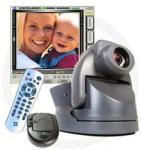
from HEI Winter 2004 , p. 106-109
-Contributed by Electronic House
| Related Articles from Electronic House |
| Systems for Your Home Office |
| High-Speed Home Office |
| Room by Room: Home Office |
Install cameras in and around your house to see what's happening at all times
Around 2 a.m., you hear a loud rapping at the front door. Should you answer it or ignore it? Although visitors in the middle of the night are fairly uncommon for most people, we've all grappled with the door-answering dilemma at some point. One the one hand, the late-night caller could be a friend or a neighbor in trouble. No danger in letting him inside. On the other hand, the visitor could be a complete stranger. If that's the case, it's probably not a good idea to invite him in even if he doesn't seem dangerous.
On nights (and days) when your imagination is running wild, having a way to see from a distance who's at the door can provide a huge sense of security. When professionally installed and configured, a security camera aimed at the welcome mat can give you the visual assurance you need to protect your home and family.
Of course, the front door is only one place to install a security camera. Outside, these devices can be situated to watch over a swimming pool, the backyard -- every square inch of your property if you so desire. Inside, cameras can monitor any room at all (children's bedrooms and playrooms are the two of the most popular spaces to monitor).
The Rooms
Deciding which areas you'd like to visually monitor is only part of the planning process. Because windows, furniture, lamps, even the architecture of a room can affect the performance of a surveillance camera, it's important that each location be camera ready. For example, to ensure that light doesn't wash out the picture, cameras should be mounted on the same wall as or adjacent to a large window. Also think about the furniture placement so that tall bookcases, armoires and other elements won't block the view of the camera.
Outside, the sun can cause cameras to experience periods of blindness as the sun moves across the sky. For this reason, avoid mounting cameras so that they face due east or west. Also be sure to inspect the blueprints of both your home and landscaping to ensure that no architectural detail or tree limb will cast a shadow over the camera or obstruct its line of sight.
Finally, don't forget about areas far from the house like the driveway entrance, a guest house or a tool shed. Even if you don't install a camera in these areas right away, it's still smart to have your security contractor trench and run plastic conduit from the foundation of the house to each possible camera location. That way, the wiring can simply be fished through this conduit when you're ready to add the cameras.
Camera Types
Naturally, if you plan to monitor outdoor areas, look for a security camera that is weatherproof and/or waterproof. Although these cameras are designed to withstand the elements, most professional security installers recommend sheltering them from direct contact with the wind, rain and sun by mounting them underneath eaves and other pieces of a home's architecture.
Some cameras do a better job at seeing at night that others. This feature is rated in a measurement called "lux." The lower the lux (.5 is very good), the better a camera's night vision. Another way to ensure a good nighttime view is to utilize a camera with a built-in infrared illuminator.
Other differentiating features are mostly a matter of personal preference. For example, some cameras display images in black and white, while others do so in color. There's no difference, really, in what you see, just in how you see it. If you plan to view the images on a high-definition TV and demand crisp video from your security cameras, look for high-resolution cameras. A rating of 480 lines is considered high resolution, while a rating of between 350 and 380 lines is standard.
Add-on Features
A security camera can become an even more versatile and useful tool by adding a few accessories to it. Pan-and-tilt mechanisms, for example, enable a camera to move left to right and up and down for a better view. With the help of a "multiplexer," meanwhile, multiple cameras can be viewed simultaneously on the screen of any TV. Finally, if you'd like to keep up on the action while you're out of town, consider tying the security cameras into a web-enabled home network that's installed when your house is built. From a computer, PDA or other web-enabled device, you can view the scenes from your cameras remotely from anywhere in the world. To simplify the installation of equipment, some cameras even have web browsers built in.




